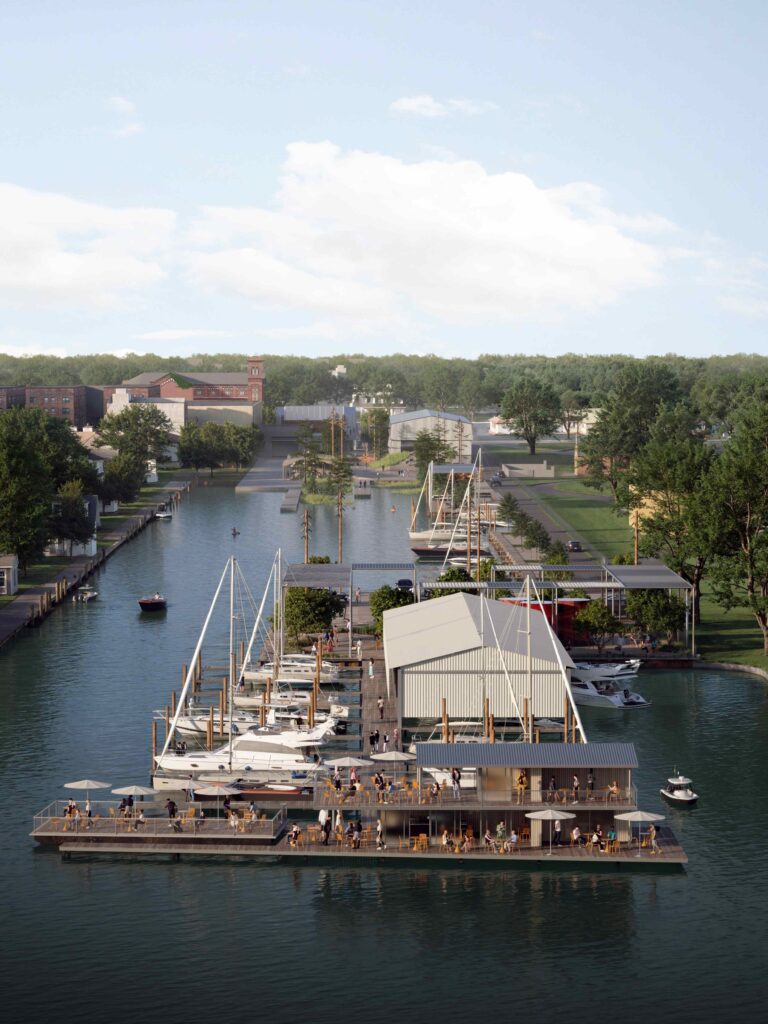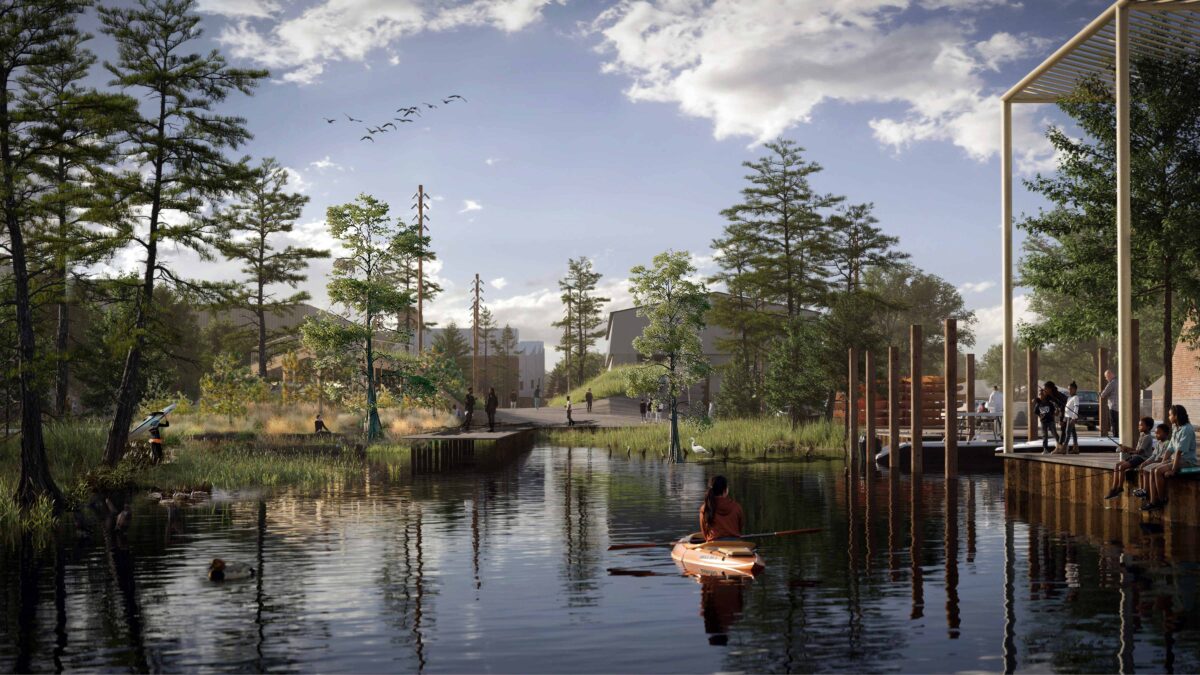Overview:
- "Stanton Yards is a natural extension of the work we're doing in Little Village," developer Anthony Curis tells Planet Detroit.
- The site on the Detroit River once included a shipyard active during World War II.
- Habitats for fish and wildlife are integral to this waterfront project.
This story is published in partnership with Great Lakes Now.
Stanton Yards, a Detroit riverfront development, aims to be a gathering place where people find inspiration in art and reconnect with nature.
The waterfront attraction is planned as an extension of the Little Village cultural corridor developed by Library Street Collective co-founders Anthony and JJ Curis. Stanton Yards is off East Jefferson Avenue, across the Detroit River from the east end of Belle Isle, and adjacent to the Great Lakes Water Authority’s Waterworks Park.
The Stanton Yards project aims to transform a storage- and service-based marina site into a 13-acre cultural gathering place for the community, featuring over 80,000 square feet of commercial and creative space, 85 boat slips, and public waterfront parkland.
The Stanton Yards site, formerly known as Gregory Marina, includes former marina showrooms, marina storage buildings, service shops, and an old theater. The site has a substantial hardscape and no public access. The Curises purchased the property in 2023, according to the project developers.
The first portion of Stanton Yards is projected to open by fall 2026, said Simon David, the project’s lead designer, and the principal and creative director at OSD, a New York design firm specializing in sustainability.
Little Village, in Detroit’s East Village neighborhood, aims to foster an inclusive community centered around the arts. It’s named this year as one of Time magazine’s “World’s Greatest Places.”
A former 100-year-old Roman Catholic church transformed into an arts and community hub, The Shepherd, anchors Little Village, along with an art education and exhibition facility, the LANTERN.
“Stanton Yards is a natural extension of the work we’re doing in Little Village and will connect to other Detroit arts-driven projects like the Shepherd and LANTERN,” Anthony Curis told Planet Detroit.
“We are transforming a cluster of vacant storage buildings into a mix of cultural, commercial, and hospitality-driven spaces, while reimagining the grounds into a network of pedestrian-accessible spaces and parks for the Detroit community to enjoy.”
Curis declined to comment on the estimated cost of the Stanton Yards development.
An investment of $15.6 million is being made in Stanton Yards, a figure that includes property acquisition costs, according to a 2024 report from the Detroit City Council’s legislative policy division regarding a tax exemption that was ultimately approved for the development.
New vision for stretch of Detroit’s riverfront
The goal of Stanton Yards “is to reinvigorate an old waterfront property with new destinations for community, art, ecology, and in doing so, help reconnect people with the Detroit River,” said OSD’s David.

People’s connection to nature has declined by more than 60% since 1800, according to a recent study reported in The Guardian.
The researcher behind the University of Derby study calls for introducing children to nature at a young age, and said the greening of urban environments are the most effective interventions.
Stanton Yards is an example of a private sector development that’s greening an urban environment.
The site’s history encompasses a shipyard that was active during World War II, a former theater, marina showroom, and service shops, according to the developers.
To honor the site’s history along the Stanton Canal, the design ties together existing buildings and a functioning marina into a single arts-focused campus that blends art with nature.
“As Detroit undergoes a waterfront renaissance, Stanton Yards shows the importance of designing from the outside-in, giving priority to people, land, and water as a means to creating a thriving new community destination for the city,” David said.
The design includes indoor and outdoor programming, plazas, parkland, waterfront promenades, and a new building, the Dune House, that includes a coastal-inspired waterfront restaurant and offices.
A key sustainable design element is pretreating all stormwater generated onsite through a combination of mechanical devices — separators and screens that remove pollutants and trash — and bioswales that mimic nature, David said.
Bioswales, a kind of green infrastructure, are shallow, linear vegetated channels designed to slow down stormwater runoff, filter pollutants, and allow the water to infiltrate into the ground.
Green gathering place on the Detroit River
Habitats for fish and wildlife are integral to this waterfront development.
“The project will naturalize the shoreline to include some coastal wetland elements,” said Ethan McKnight, an OSD landscape designer working on the Stanton Yards project.
Coastal wetlands are known as nurseries of life that provide shelter and essential resources for the growth of many animals and plants. The Stanton Yards team said they will add armorstone to approximately 375 feet of existing steel sheet-piled shoreline, and will install native, aquatic plants.
The Stanton Yards design incorporates a new, small habitat island that will provide an additional 150 feet of shoreline habitat to help increase biodiversity. Basking logs will be installed for turtles, frogs, and toads.
More than 170 trees and about 200 shrubs will be planted to provide stopover habitat for birds, green the site, and help address the urban heat island effect – the increase in temperature caused by human-made structures.
From a fish and wildlife perspective, three dynamics make the project significant.
First, the Detroit River has lost 97% of its coastal wetlands, making this coastal wetland rehabilitation effort valuable.
Second, 57% of the entire Detroit River shoreline is historically hardened with concrete breakwaters and steel sheeting piling to accommodate industry and commerce, providing no habitat benefits to fish and wildlife. This project is important because it softens a historically hardened shoreline with habitats.
Third, few backwater areas exist along the 32-mile length of the Detroit River, and the vast majority are hardened with concrete breakwaters and steel sheet piling for marinas, industry, and shipping.
Rehabilitating coastal backwater areas will provide spawning and nursery habitats for many fish species.
This is critically important to young larval fish, as these areas provide shelter, resting areas, food, and a chance to grow a little bigger and stronger on their journey downstream to Lake Erie. Indeed, Detroit River research has shown how restoring backwater habitats as nursery areas for larval fish is necessary to achieve fishery restoration goals.
Stanton Yards as ‘third space’ for Detroit
Waterfronts are magical places where the water meets the land, and people can reconnect with nature and one another.
Welcoming, accessible, green, riverfront gathering places, like the Detroit Riverwalk and the Stanton Yards plan, do not happen by accident. According to leaders of the Belle Isle Conservancy, Huron-Clinton Metroparks, and the Joe Louis Greenway Partnership, it happens through compelling vision, collaboration, and investment.
Championing waterfront developments that integrate community, art, nature, and culture also helps create a “sense of place” that can foster a stewardship ethic and civic mindedness.
Another way of thinking about Stanton Yards is as a “third place” – a phrase coined by urban sociologist Ray Oldenburg in his 1989 book “The Great Good Place.”
Oldenburg defined a “third place” as a social gathering space outside of the home (“first place”) and work (“second place”). A third place is a familiar public spot where people regularly connect, socialize, and build community over a shared interest or activity.
Perhaps Stanton Yards is worth putting on your wish list for fall 2026 to experience Detroit’s new “third place” that celebrates the intersection of art and nature.
MORE DETROIT RIVER COVERAGE
Jefferson Chalmers looks to seawalls to overcome flood insurance burden
“It’s such a unique neighborhood, and there’s a lot of work that needs to be done to come up with a fix that is equitable,” says Jefferson Chalmers resident Dan Piepszowski.
Detroit’s Port Authority sustainability manager works to cut emissions, build trust with neighbors
Taylor Mitchell, Detroit Wayne County Port Authority’s inaugural sustainability manager, spearheads initiatives to curb diesel emissions and achieve net zero emissions at 23 private terminals along the Detroit and Rouge rivers by 2040.
Detroit River nonprofit targets wetlands loss with island habitat restoration
The Detroit River lost “probably 95%” of its coastal wetlands, “particularly on the Detroit side,” says riverkeeper Bob Burns.





